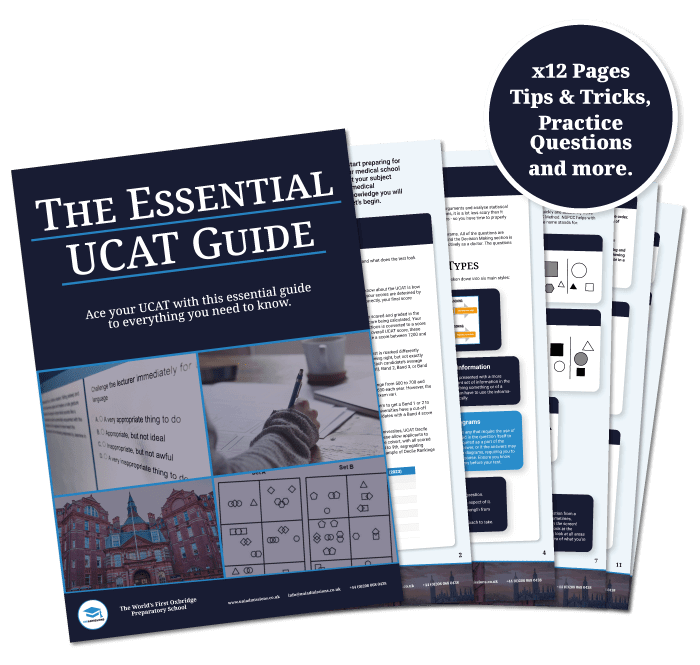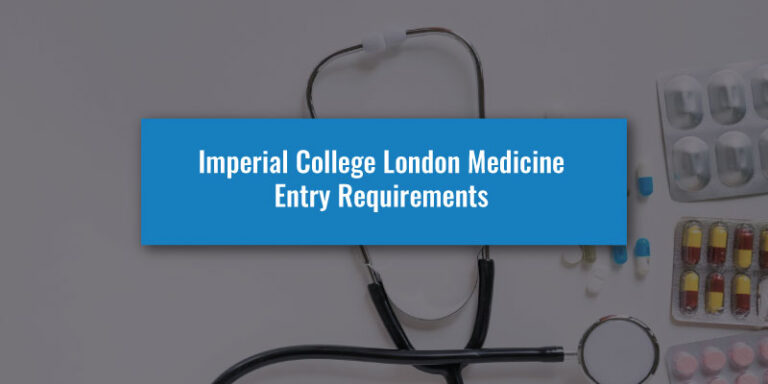UCAT CHANGES 2025
The Abstract Reasoning subtest will be removed from the UCAT in 2025. This will impact the timings and question totals of most other subtests. At UniAdmissions, we aim to provide the most recent information to all of our visitors as soon as possible.
UCAT Decision Making assesses your ability to apply logic to reach a decision or conclusion, evaluate arguments and analyse statistical information.
This might sound intimidating at first, but when you break it down into the different questions, it is a lot less scary than it sounds. Decision Making is also the least time-pressured section of the test, so you have time to properly digest the information in front of you to form your answers.
This subtest is one out of the four sections in the UCAT. The other three are:
In this UCAT Decision Making guide, we explain what the section is about, the questions that can come up and the way it is scored, with some final tips added as an extra bonus.
What is the UCAT Decision Making Section?
The UCAT Decision Making section is one of 4 UCAT subtests and it contains 35 questions that need to be answered in 37 minutes. This means you have time to spend on each question but you still need to work quickly and efficiently. You will be presented with questions that may refer to text, charts, tables, graphs or diagrams. All of the questions are standalone and do not share data, so make sure to focus on each question independently.
The idea behind the Decision Making section is to assess how you use information and data to make decisions – a skill that is essential to working effectively as a doctor. The questions come in a variety of styles, but all are focused on testing your decision-making ability.
Decision Making is a tough section of the UCAT. Through effective preparation, it is possible to score highly.
There is no need to worry though as our UCAT Programme gives you expert support through many different avenues of learning, such as one-to-one tuition, comprehensive preparation materials and intensive courses.
UCAT Decision Making questions
Here is a typical Decision Making question, along with the answer:
The questions you will face can be broken down into six main styles which we have covered in detail below:
Logic Puzzles
The logical puzzle questions require you to make an inference based on the available information to get to the answer. This will usually be presented with background information (general statement), then extra information (a specific statement), and both should be combined to find the conclusion and answer. This can be either positive or negative, which is explained in the diagram below.
Syllogisms
Syllogisms are an additional application of deductive reasoning. In these questions, you will be presented with information that can be used to make certain conclusions, but which will also give an incomplete description of the situation. Then, the task is to determine which answer/answers is/are supported and which aren’t.
Interpreting Information
For the interpreting information questions, you will be presented with a more complex and less directly relevant set of information than in the logical deduction questions. This information may be in the form of a passage of text describing something, or alternatively, it could be in the form of a table, chart or graph. You will then have to use the information
This type of question is usually best conquered with a diagram as Zenab shows in the Decision Making video below.
Recognising Assumptions
Many of these questions will ask you to select the strongest argument for or against a statement. To help you select the best option, use the acronym FREES.
Factual – the argument should be based on fact rather than opinion.
Relevant – the argument should directly address the statement in the question.
Entire – the argument should address the whole question, not only one aspect of it.
Emotionless – the argument should avoid emotional pleas and derive strength from relevant evidence.
Sensible – the argument should be a generally sensible and reasonable approach to take.
Venn Diagrams
The category of “Venn diagram” questions encompasses any that require the use of Venn diagrams within the question. Venn diagrams might be used in the question itself to present the data, they may be required as a part of the working to deduce the correct answer, or it may be that the answers are presented in the form of Venn diagrams, and you have to choose the most appropriate response.
Probabilistic Reasoning
You may be presented with probabilistic information in a variety of forms – fractions, decimals, percentages or odds – remind yourself of these different notations if you haven’t seen them in a while. Whenever you see a probability, take the time to note exactly what occurrence the probability is representing, and whether it is the positive probability (of a thing happening) or a negative probability (of it not happening).
Top UCAT Decision Making Tips
Develop a clear approach to each type of question.
There is no overall solution that works for every question, so having a strategy for each is imperative if you want to ensure consistent success in the test.
Draw diagrams where possible.
You can almost always visualise information better than you can read it – save valuable brain power and draw! Don’t worry, they’re not going to be looked at in the marking so they can be as quick and rough as necessary.
Read the question first where applicable.
This is a running theme. Read the question before reading the information presented, whether this is text, a table or graph. You’ll easily be able to spot what you need.
Claim Your FREE Essential UCAT Handbook
The UCAT is a requirement for most medical schools in the UK, so it’s important that you are well-prepared so you can score highly and earn your interview invitations. With our Essential UCAT Guide, you will find a detailed breakdown of each section, preparation tips, practice questions and more. Fill out the form below to gain free access right away!

What is a Good UCAT Decision Making score?
The overall score for the first four sections of the UCAT test is generally more important than scores for individual sub-sections, as this is what is primarily evaluated for assessment. A score above 2,000 is generally considered a good (or high) score for the UCAT, but this can vary depending on the specific university you are applying to. This score is considered competitive for most universities.
As for Decision Making section specifically, we can have a look at previous average scores to gauge what a good score may be:
Average UCAT Decision Making Score (2021)4
620
Average UCAT Decision Making Score (2023)
623
Average UCAT Decision Making Score (2022)
616
From this, we can say that a score in the 615 to 625 range would be average, while a score above 650 would be very competitive by most universities’ standards. You can learn more about all of the UCAT Universities in the UK within our UCAT Medical Schools Guide.
That covers the essential knowledge for the Decision Making section of the UCAT. There’s still plenty more to learn about the UCAT though, so check out our other sub-section guides to familiarise yourself with the whole test. Find out how you can maximise your preparation and triple your chances of success with our expert UCAT Tuition Programmes today!
Searching for UCAT support to strengthen your Medicine application?
The UCAT exam is a vital component of your Medicine application so scoring highly can mean the difference between an offer or rejection. At UniAdmissions, we are experts at boosting your UCAT score and maximising your chances of gaining a place to study Medicine.
Discover our UCAT Programme by clicking the button below to enrol and triple your chances of success.










